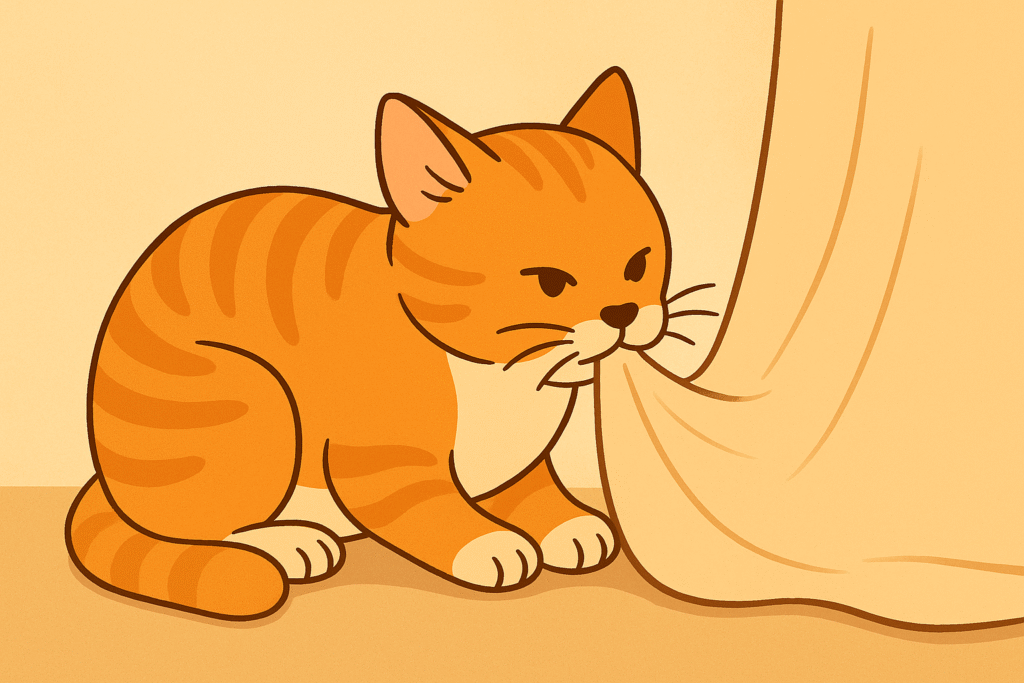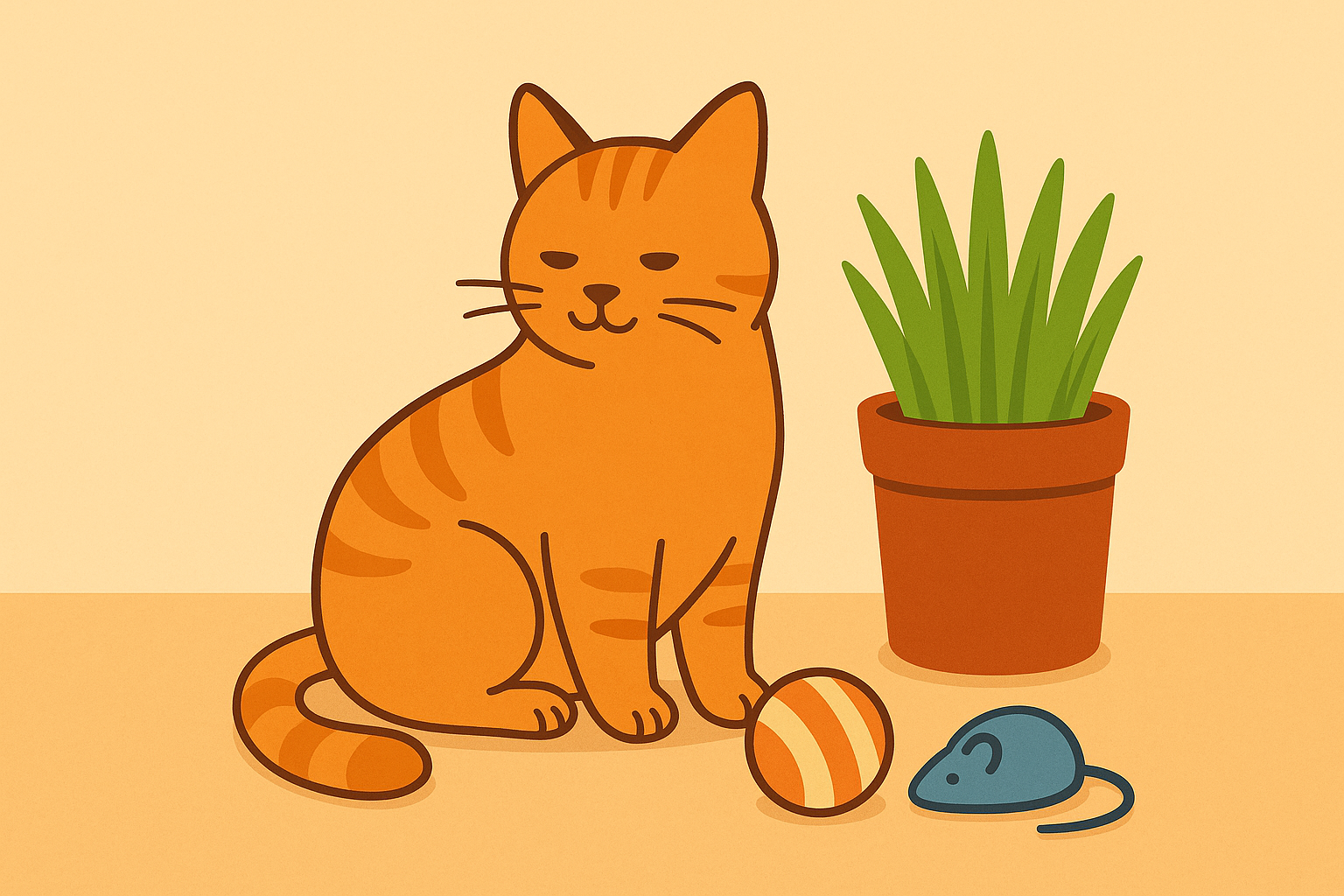When “Just Playing” Turns a Little Strange
Every cat parent knows that curiosity runs deep in those tiny whiskered faces.
One moment, they’re chasing dust bunnies under the couch. The next, they’re trying to eat the couch.
Maybe you’ve caught your cat chewing on a blanket corner, or found a half-chewed shoelace on the floor and wondered — why on earth do they do that?

It’s not as rare as it sounds. Some cats have a habit called pica — the urge to eat things that aren’t food.
And while it sometimes looks funny (that guilty little face mid-chew), it can be dangerous if it goes too far.
The Soft Start: “Wool-Sucking”
It usually begins innocently enough.
Kittens taken from their mothers too early often find comfort by “nursing” on soft things — sweaters, blankets, even their human’s earlobes.
This is called wool-sucking, and it’s their way of self-soothing, much like a baby sucking a thumb. It’s adorable… until they start swallowing bits of fabric fuzz.
That’s when it edges into risk territory.
Once a cat realizes chewing calms them, they might start exploring more interesting textures — paper, plastic, even electrical cords. What started as comfort can quietly shift into compulsion.
It Might Be in Their DNA
Some breeds — Siamese, Burmese, and Birmans — are more prone to wool-sucking and pica. It’s almost like it’s written in their genes.
They’re sensitive, clever, and emotional cats, which makes them more likely to chew when they’re stressed or bored.
If your cat happens to be from one of these breeds, it doesn’t mean trouble is guaranteed. It just means you need to keep a closer eye (and maybe hide the socks).
When the Body Sends the Wrong Signals
Sometimes it’s not the brain — it’s the body.
Cats missing key vitamins or minerals might crave strange textures because their body is trying to “fix” something.
Anemic cats sometimes lick or eat cat litter. Malnourished cats may chew plants or grass to make up for missing nutrients.
It’s their way of saying, “Hey, something’s off here.”
If your cat suddenly develops odd eating habits, it’s always worth calling your vet. A quick blood test can rule out hidden deficiencies — and spare you from finding bite marks on your curtains.
When It’s More Than a Quirk
According to vets, certain health problems can trigger pica-like behavior, including:
- Feline Leukemia (FeLV)
- Feline Immunodeficiency Virus (FIV)
- Diabetes
- Neurological conditions or brain tumors
It doesn’t mean your cat has one of these — but it’s a reminder not to dismiss the behavior as “just weird.” Sometimes, their strange little habits are quiet cries for help.
The Role of Boredom (and a Little Bit of Drama)
Cats might act independent, but deep down, they’re emotional creatures.
A bored cat can turn mischievous fast. A lonely one can turn destructive.
Chewing random things can be a cry for attention — “Hey, notice me!” — or just a way to kill time.
If your cat lives indoors full-time, think about how much stimulation they get each day.
A new feather toy, a cardboard box, or even a sunny window seat for bird-watching can change everything. Ten minutes of active playtime can replace hours of restlessness.
The Big Question: Why Do They Really Do It?
There’s no single answer.
Sometimes it’s genetics, sometimes stress, sometimes boredom or diet — often a mix of all three.
The trick is paying attention to when and what they chew. Do they target the same thing every day? Only do it when alone? These little details help your vet (and you) figure out what’s behind it.
Step 1: Rule Out the Medical Stuff
If your cat eats or chews things that clearly aren’t food, start with the vet.
Describe what you’ve noticed — the timing, the items, even their behavior before and after.
Once you’re sure it’s not a health problem, you can focus on behavior training and environmental tweaks.
Step 2: Hide the Temptations
Cats are opportunists. If it’s within reach, it’s fair game.
So, start by keeping tempting items out of sight:
- Rubber bands, cords, and plastic bags
- Clothes or blankets they love to suck on
- Toxic plants or loose strings
Replace these with safe chew alternatives — soft cat toys, crinkle balls, or a little pot of cat grass.
Redirecting their curiosity keeps them busy and safe.
Step 3: Keep That Curious Mind Busy

A tired cat is a good cat.
Try rotating toys every few days to keep things interesting.
Set up a perch by a window for bird-TV.
Or teach your cat to walk on a harness — yes, some actually love it.
Puzzle feeders and treat-dispensing toys work wonders too. They keep your cat thinking and moving, which means less time plotting how to eat your sweater.
Step 4: Make the Wrong Things Smell “Wrong”
Cats have powerful noses — and strong opinions.
A few scents top their “absolutely not” list: citrus, vinegar, and lavender.
Lightly misting a fabric or area they keep targeting with a cat-safe citrus spray can convince them to move on quickly.
For wires, use protective tubing — it’s simple, cheap, and can save both your cat and your electronics.
Step 5: Give It Time (and Grace)
No behavior vanishes overnight.
It takes patience, and sometimes a sense of humor.
One week you might think it’s fixed, and the next, you find a blanket corner mysteriously damp. That’s okay. Progress isn’t perfect — it’s gradual.
Celebrate the small wins. If your cat used to chew daily and now only occasionally, that’s success.
Living with a Cat Who Has Pica
Some cats stop completely. Others mellow out but keep a soft spot for odd textures.
Either way, it’s manageable with love and consistency.
Pica doesn’t make your cat “bad” — it just means they’re looking for comfort in unusual places. Once they learn other ways to feel safe, the habit fades.
And when you catch them doing it, remember: this isn’t rebellion. It’s communication.
A gentle redirect and a bit of patience will do more good than any scolding ever could.
🐱 FAQ
Q1: What is pica in cats?
It’s when cats eat or chew things that aren’t food — fabric, plastic, plants, or other household items.
Q2: Why does my cat suck on blankets?
That’s likely wool-sucking — a comfort habit, especially in cats separated from their mothers early.
Q3: Should I punish my cat for eating weird things?
Never. It raises their stress and can make the behavior worse. Redirect instead.
Q4: Is pica dangerous?
It can be if they swallow something that blocks their intestines or poisons them. Always check with your vet.
Q5: Will it ever go away?
Many cats outgrow it or manage it with time, love, and the right environment.
Final Thoughts
If your cat’s strange chewing habits have you scratching your head, remember: cats express themselves in ways that don’t always make sense to us — but they make sense to them.
Your role isn’t to stop them cold; it’s to guide, protect, and understand.
The blanket nibbling, the plastic fascination, the grass chewing — it’s all part of their little language.
And when you respond with care instead of frustration, your cat learns something powerful:
“I’m safe here.”
That’s when the healing starts — not just for their behavior, but for your bond, too. 🐾